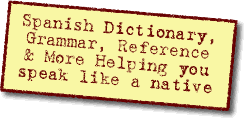Ask a Question(Create a thread) |
|
|||||||
Hola again!Don't be shy, come introduce yourself. |
 |
|
|
Thread Tools |
|
#1
|
|||
|
|||
|
Hola again!
¡Hola otra vez a todos! I was trying to learn Español over un año ago, but since then I moved away from California and have had trouble aprendiendo Español. Ahora yo soy back y yo quiero aprender Español. Any help on where to start would be great. I forgot pretty much everything I learned a few years ago. ¡Gracias!
Eric Last edited by ericrcan; September 27, 2012 at 12:19 AM. |
|
Get rid of these ads by registering for a free Tomísimo account.
|
|
#3
|
|||
|
|||
|
¡Gracias wrholt!
Both el tiempo, y the resources. Living in Hawaii, not many personas sabe Español. Este semana, mi papa got married a una mujer de Tijuana. Así ahora yo quiero aprender ser able hablar a ella y la hija de ella. Last edited by ericrcan; September 27, 2012 at 03:17 AM. |
|
#8
|
||||
|
||||
|
Other than the that-is-how-this-particular-phrase-is-said answer, it'll be a bit hard to explain, but I'll try.
It has to do with 'obligation'. Obligation can be expressed with 'tener que' (there are other ways, too). tener que (hacer algo) = (to) have to (do something) tengo que ir = I have to go tienes que estudiar = you have to study tener mucho que hacer = (to) have a lot to do tener nada que hacer = (to) have nothing to do You may also be interested to know that the English infinitive is often coupled with the preposition 'to' - to have, to see, to eat - but it's not necessary to do that. The preposition is NOT a part of the verb. English has a bare infinitive (no leading preposition). When we look in an English dictionary for a verb, we search for the bare infinitive form. We use bare infinitives all the time in English. For instance, a bare infinitive always follows a modal (must, can, could, should, will, shall, would, may, might, etc.). But, others, like 'need to', 'have to', 'ought to', must be followed by the preposition 'to'. The Spanish infinitive isn't coupled with a preposition, nor is one 'built into' the infinitive, just like its English counterpart! Textbooks and some teachers would have you believe otherwise. They always include the preposition 'to' in front of the infinitive when they're introducing a new infinitive, but the preposition 'to' is NOT a part of the infinitive. There'd be a lot less confusion if the bare infinitive were pressed into service instead. Spanish and English differ in some points. While English doesn't allow 'I want go', Spanish does (quiero ir). English doesn't allow 'I need eat', but Spanish does (necesito comer). In English, 'I have to go' cannot be said without the preposition. In Spanish, it can't be said without 'que' preceding the infinitive. Many Spanish verbs are always followed by a particular preposition. These should be memorized as a pair. |
|
#10
|
||||
|
||||
|
Remember, after 'can' you use a bare infinitive, in both languages.
'Ayúdame' is the familiar imperative (command) form. No te puedo recomendar un sitio web. (Aprendí a hablar español antes de que existiera el internet.) No quiero que te desanimes, pero no he encontrado ninguno que me guste. Te recomiendo evitar los sitios que cuentan con profesores cuya lengua materna no sea el español. 
Last edited by Rusty; September 29, 2012 at 03:12 PM. |
|
#11
|
|||
|
|||
|
Gracias por las correcciones Rusty. I will look around para un libro de español en la biblioteca. Ahora es el momento de look around the rest del foro para la práctica. ¡Gracias otra vez!
-Eric Last edited by ericrcan; September 29, 2012 at 03:11 PM. |
 |
«
Previous Thread
|
Next Thread
»
| Link to this thread | |
|
|
|||||||
All times are GMT -6. The time now is 07:54 AM.







